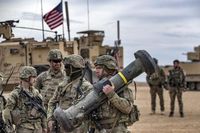India’s relationship with the United States has hit a turbulent patch, as New Delhi reportedly pauses major military procurement deals with American defense giants in response to a dramatic escalation in U.S. tariffs. The move, which Indian officials describe as a clear signal of displeasure, comes after President Donald Trump imposed a steep 25% additional tariff on Indian exports on August 6, 2025, pushing total duties to a staggering 50%—among the highest for any U.S. trading partner, according to Reuters.
The tariffs, announced as a punitive measure for India’s continued purchases of discounted Russian oil, have sent shockwaves through bilateral ties that had, in recent years, been marked by deepening defense cooperation and shared strategic interests in Asia. The new duties have not only raised the cost of Indian goods in the U.S. market but also cast a shadow over multi-billion dollar defense deals that were on the brink of being finalized.
Among the most high-profile casualties is a $3.6 billion contract for six Boeing P-8I maritime reconnaissance aircraft, which was in its final stages before the freeze. Talks also stalled over the acquisition of Stryker combat vehicles and Javelin anti-tank missiles from U.S. firms including Lockheed Martin, Boeing, and General Dynamics (Benzinga, AINvest, Reuters). Indian Defense Minister Rajnath Singh’s planned visit to Washington—intended to announce these major deals—was quietly cancelled, marking what officials say is the first concrete sign of India’s displeasure over the tariff burden.
While no formal written order has been issued to cancel the U.S. arms deals, Indian government sources told Reuters that negotiations have effectively been frozen, allowing New Delhi to quickly revisit its position if circumstances change. The government, however, has publicly denied any official suspension, calling reports of a procurement pause “false and fabricated” and insisting that talks are proceeding “in accordance with extant procedures.” Yet, the underlying message is clear: India is reevaluating its defense procurement strategy in light of the new economic reality.
The move has far-reaching implications for both countries. India is the world’s second-largest arms importer, and in recent years, it has shifted its procurement focus from Russia—its long-time supplier—toward the U.S., France, and Israel. This strategic realignment was seen as a cornerstone of a broader partnership aimed at counterbalancing China’s growing influence in the region. The sudden chill, however, exposes the fragility of even the most robust alliances when economic and geopolitical interests collide.
Indian officials have not minced words in their criticism of Washington’s approach. They argue that the U.S. exhibits a double standard—targeting India for its Russian oil purchases while continuing to trade with Moscow when it suits American and European interests. As one government source remarked to Benzinga, India feels “unfairly targeted, while the West continues to trade with Russia when it suits their interests.” The tariffs, they say, are not only unfair but also risk undermining years of painstaking diplomatic progress.
The Indian government’s pushback has not been limited to defense. Prime Minister Narendra Modi, speaking at the MS Swaminathan Centenary International Conference, reaffirmed his commitment to protecting Indian farmers amid the trade tensions. “The interest of our farmers is our top priority,” Modi declared, adding that he would “never compromise” on their welfare. The statement underscores the broader domestic pressures facing the government as it navigates a rapidly evolving global trade landscape.
Despite the pause in large-scale procurements, other aspects of U.S.-India defense cooperation remain active. Intelligence-sharing and joint training programs are continuing, and both sides have left the door open for a rapid resumption of talks should the tariff issue be resolved. According to Reuters, the procurement process could still move forward once there is greater clarity on tariffs and the direction of bilateral relations, though “not as soon as they were expected.”
The diplomatic spat has also prompted India to explore alternatives. While New Delhi has no immediate plans to fully abandon Russian weaponry, it remains dependent on Russian support for existing military systems. Moscow, sensing an opportunity, has offered India new defense technologies, including the advanced S-500 surface-to-air missile system. For now, Indian officials say there is no appetite for fresh Russian purchases, but the decades-long reliance on Moscow means that Russian support will remain essential for years to come (Reuters, AINvest).
The tariff escalation has also exposed deeper tensions in the U.S.-India relationship, including disagreements over Pakistan, global trade, and energy policy. Indian officials have pointed out that recent U.S. actions—such as Trump’s controversial claim to have mediated a ceasefire between India and Pakistan—have contributed to an atmosphere of mistrust. The current dispute, layered atop these existing frictions, has brought bilateral ties to their lowest point in decades, according to multiple sources.
Nevertheless, the Indian government has signaled that it is not closing the door on the U.S. entirely. New Delhi is keeping its options open, both in terms of defense procurement and broader diplomatic engagement. At the same time, India is exploring the possibility of strengthening ties with other BRICS nations as a hedge against U.S. trade pressures. Brazilian President Lula da Silva, for example, has suggested that the bloc could coordinate to counteract American economic leverage (Benzinga).
Meanwhile, the impact of the tariffs is already being felt in global energy markets. Russian oil producers, once heavily reliant on Indian buyers, are now rushing to divert shipments of their flagship Urals crude to China after India started reducing purchases in response to the new U.S. sanctions. The shifting trade patterns highlight the interconnectedness of global markets—and the unintended consequences of economic brinkmanship.
For now, the U.S.-India defense partnership remains at a crossroads. Both sides acknowledge the importance of the relationship, but the current standoff serves as a stark reminder that strategic alliances can be upended by economic disputes and shifting geopolitical winds. Whether the two democracies can find common ground and restore momentum to their partnership remains to be seen, but the stakes—for regional security, global trade, and the balance of power in Asia—could hardly be higher.
As the world watches, New Delhi and Washington must weigh their next steps carefully. The outcome will shape not just the future of their own relationship, but the broader contours of international diplomacy in an increasingly multipolar world.

